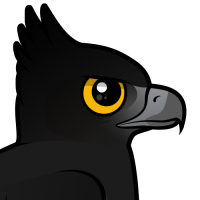Black Hawk-Eagle
About the Black Hawk-Eagle


The Black Hawk-Eagle, a striking bird of prey, thrives in the dense tropical rainforests of Latin America, from Mexico through Central America to Argentina. Its name comes from its predominantly black plumage, which gives it a sleek, stealthy appearance. The eagle also features distinctive white bands on its tail and a white patch under its wings, visible during flight.
Adult Black Hawk-Eagles are known for their piercing yellow eyes and sharp talons, attributes that make them formidable hunters. They primarily feed on medium-sized birds and mammals, such as monkeys and squirrels, adeptly maneuvering through the forest canopy to catch their prey. Their calls are loud and distinctive, often heard before the bird is seen, echoing through the forest.
This species prefers undisturbed primary forests and is occasionally found in more open areas near forest edges. They build large stick nests high in tall trees, where they typically lay one to two eggs. The Black Hawk-Eagle plays a critical role in its habitat, helping control populations of smaller animals and maintaining ecological balance.

Details & Statistics
Range
International Names

































